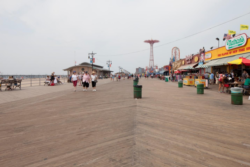
Coney Island Boardwalk. Image credit: LPC.
Many speakers asked Landmarks to seek more binding control to ensure the boardwalk’s wood planking is replaced in kind. The Landmarks Preservation Commission held a hearing on the potential scenic landmark designation of the Coney Island Boardwalk at its meeting on April 17, 2018. The designation would include the boardwalk and all structures on it, including furniture, concession pavilions, comfort stations, and lifeguard stations. A 100-foot-wide corridor of sand below and adjoining the boardwalk would be included in the designation.
The boardwalk originally opened in 1932. Coney Island’s history as a beachfront resort dates to the early 19th century, but until the State acquired the property and transferred it to the City with the intention of building the boardwalk, the beachfront at Coney Island had been privately owned. The construction of the Boardwalk was inspired by the success of the Atlantic City Boardwalk, the nation’s first such attraction free to the general public. The original boardwalk, and planked deck supported concrete pilings and girders was designed by engineer Philip P Farley and was 80 feet wide, and 9,500 feet long. An extension was completed in 1926. The Parks Department assumed control of the Boardwalk in 1938, and under Robert Moses, the boardwalk was straightened and moved inland and extended a further 1,500 feet. The beach was also expanded in 1940. The Boardwalk’s current length is 2.7 miles.
The Boardwalk granted access to the waterfront to people of all social backgrounds, where they commingled on a common thoroughfare. It has featured prominently in popular culture since its construction and is iconic worldwide. The Boardwalk is also home to the idiosyncratic annual tradition of the Mermaid Parade. Individual City landmarks connected to the Boardwalk include the Parachute Jump, The Cyclone, and the Childs Restaurant Building.
The designation would be primarily based on the Boardwalk’s historical and cultural significance, as little, if any, or original 1932 fabric remains. In recent years, some wooden planking has been replaced with longer-lasting composite plastic lumber or concrete.
As a scenic landmark owned by the City, Landmarks oversight of the property would be advisory, with the Public Design Commission, formerly the Art Commission, holding binding review.
Council Member Mark Treyger, who represents Coney Island, spoke in strong support of the designation of the “poor man’s Riviera,” saying the Boardwalk embodies the “American democratic spirit,” and made Coney Island “a mecca of leisure for the masses.” He said the area had been threatened by “autocratic” developers and bureaucrats who ignored the wishes of the community and decried the use of plastic lumber and concrete to replace wooden boards. Treyger said landmark designations would add another layer of protection and public review, and ensure its preservation in perpetuity. Treyger thanked fellow Council Members that had backed a resolution calling for the Boardwalk’s consideration as a scenic landmark. A representative of Council Member Chaim Deutsch also spoke in favor of designation.
The Historic District Council’s Simeon Bankoff said the Boardwalk undeniably merited designation, but said Landmarks’ interpretation of its policing power abrogated “almost all authority the agency might exercise over this property.” With Landmark’s role limited to an advisory capacity, the Public Design Commission and Park Department, who have allowed the replacement of wooden planking with concrete and plastic would retain ultimate control. The Society for the Architecture of the City’s Christabel Gough said a “purely honorific” designation was inadequate, and what was desired was “a real boardwalk made of real boards of wood, just as it always was, and should be.” Andrea Goldwyn of the New York Landmarks Conservancy endorsed designation and said she hoped it would trigger a reevaluation of the practice of replacing wood with substitute materials. Goldwyn said the Boardwalk was “not just a place, but a tangible artifact which was historically wooden.”
An area resident said using replacement materials instead of wood diminished the identity and experience of the Boardwalk and urged Landmarks to assert its authority to maintain the Boardwalk’s historic character. Another resident called the boardwalk “a unique pedestrian entity comprised of wooden boards,” and stated that even if the wood planking was not the original wood, it was still the same material, and merited preservation.
Chair Meenakshi Srinivasan stated that communications in support of designation had been received from Assembly Member Steven Cymbrowitz, the Alliance for Coney Island, and the Parks Department.
In response to Commissioners questions, Commission attorney John Weiss stated that, if designated, Landmarks would have binding control over existing buildings on the boardwalk, but not the boardwalk itself, or its railings and furniture, because it was a “structure” that was part of “a landscape feature,” and not a “building.” Executive Director Sarah Carroll stated that Landmarks’ oversight of City-owned scenic landmarks had long been advisory, to prevent duplicative review of spaces under the Public Design Commission’s jurisdiction.
Commissioner Ad Shamir-Baron challenged the assumption that the boardwalk itself was not an “existing building.” Carroll said the matter would be investigated.
The Commission will hold a vote on designation on May 15, 2018.
LPC: Coney Island Boardwalk, Brooklyn (LP-2583) (Apr. 17, 2018).
By: Jesse Denno (Jesse is a full-time staff writer at the Center for NYC Law.)

